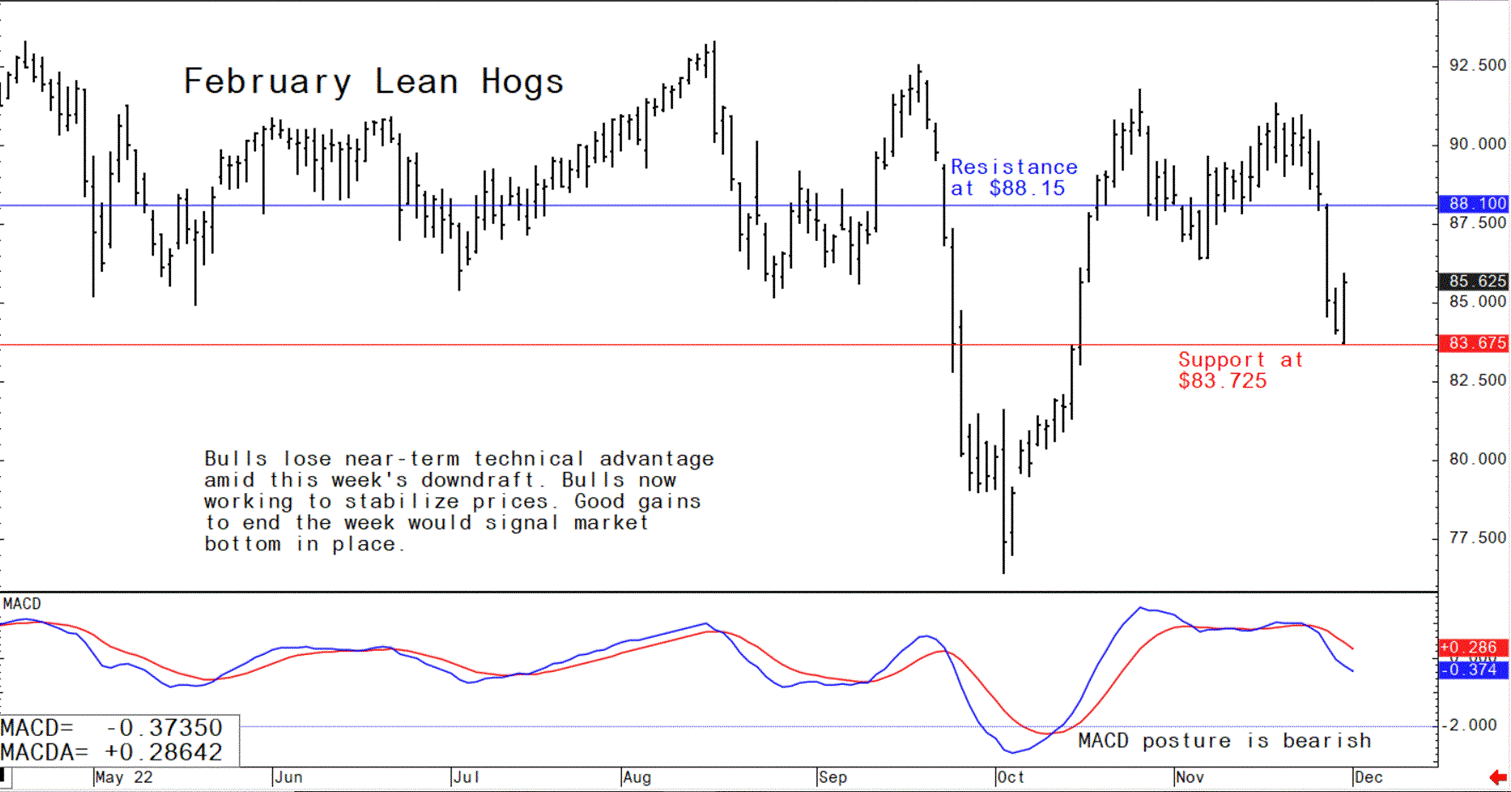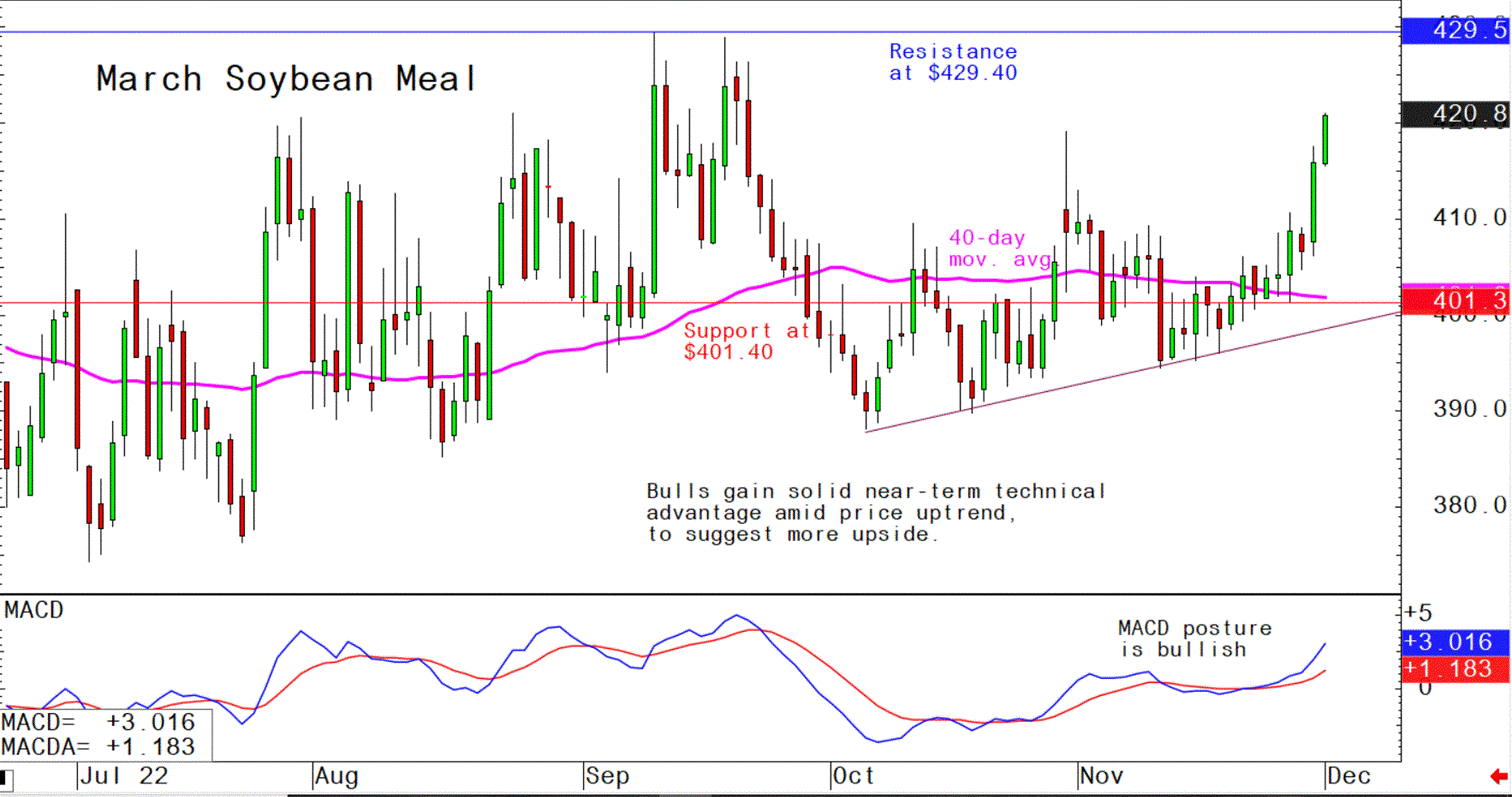



Pig outlook: Lean hog bulls is serious trouble
Analyst Jim Wyckoff shares an update on the US futures market, USDA reports and global pig newsFebruary lean hog futures this week fell to a six-week low, producing serious near-term chart damage. Bulls late this week are working to stabilize prices. The national direct cash hog price firmed $2.15 on Wednesday with gains across all regions. While the CME lean hog index continues to weaken, the strength in the direct price could signal a seasonal low is drawing closer. December lean hog futures posted strong gains Wednesday but remain around $1 below the cash index. Wholesale pork has been under pressure as packers cut prices to move product. If the lean hog futures market can post decent gains on Thursday and/or Friday, such would suggest this week’s low is a near-term price bottom.
Weekly USDA US pork exports
Pork: Net sales of 20,100 MT for 2022 were primarily for Mexico (11,800 MT, including decreases of 400 MT), Japan (4,000 MT, including decreases of 200 MT), South Korea (1,800 MT, including decreases of 100 MT), the Dominican Republic (900 MT, including decreases of 100 MT), and Canada (500 MT, including decreases of 400 MT). Net sales of 3,800 MT for 2023 were primarily for Canada (1,200 MT), Colombia (1,000 MT), China (500 MT), Honduras (300 MT), and South Korea (200 MT). Exports of 29,700 MT were primarily to Mexico (14,900 MT), China (4,100 MT), Japan (3,000 MT), South Korea (1,900 MT), and Canada (1,800 MT).
China’s sow herd marginally increases in October
China’s sow herd increased 0.4% in October from the month prior to 43.79 million head, according to the country’s ag ministry. The sow herd was 0.7% larger than October 2021.
USDA extends comment period for 45 days on livestock, poultry proposed rule on competition
Based on the Packers and Stockyards Act (P&SA), the comment period ends on Jan. 17, 2023. Several groups and lawmakers have been urging USDA to extend the comment period as the original 60-day-comment-period close of Dec. 2 approached. The National Cattlemen’s Beef Association (NCBA) welcomed the USDA decision, but urged the agency to “tap the brakes” on its entire rulemaking process under the P&SA given that this rule, a prior one filed on the poultry tournament system and a yet-to-be released rule are linked and need to be considered together.
USDA holds food price inflation outlook at lofty levels
The Consumer Price Index (CPI) for all food in 2022 is forecast to rise by 9.5% to 10.5% while food at home (grocery) prices are forecast up 11% to 12% with an increase for food away from home (restaurant) prices of 7% to 8%. Those figures would be the highest for all food since they were up 11% in 1979, for grocery store prices the biggest rise since 1974 when they moved up 12.7%, and the biggest rise in restaurant prices since they increased 9% in 1981.
The CPI for all food increased 0.7% from September 2022 to October 2022, and food prices were 10.9% higher than in October 2021. Grocery store prices were up 0.5% in October compared with September and up 12.4% from year-ago, while restaurant prices were 0.9% higher in October and 8.6% higher than year-ago marks.
Adjustments this month were in several food categories — ranges for seven food categories and one aggregate category were revised upward, while three food price categories were revised downward.
USDA analysis: USDA said the “continuing increases in the Federal funds (interest) rate by the Federal Reserve place downward pressure on prices, and prices for unprocessed agricultural commodities have decreased each month since peaking in May 2022.”
The impact of bird flu cases is being felt relative to egg prices and USDA said the situation needs to be monitored closely with over 50 million birds in 267 flocks in 46 states affected. “Retail egg prices increased 10.1% in October 2022 and reached 43.0% above October 2021 prices,” USDA said. “The ongoing outbreak of highly pathogenic avian influenza (HPAI) reduced the US egg-layer flock, as well as the poultry flock to a lesser extent. This decrease in the poultry flock and spike in HPAI prevalence are expected to increase wholesale and retail egg prices for the coming months.”
USDA also adjusted upward its forecasts for forecast ranges for fats and oils, sugar and sweets, and nonalcoholic beverages. “Economy-wide factors, including ongoing supply-chain issues and energy, transportation, and labor costs, have contributed to increases in prices across food categories,” USDA noted. “However, recent declines in agricultural commodity and energy prices are expected to ease price increases across these categories through the remainder of 2022.” Compared with 2021, USDA sees 2022 prices for fats and oils rising by 18.5% to 19.5%, sugar and sweets are predicted to increase between 10% and 11%, while nonalcoholic beverages prices are predicted to increase between 10.5% and 11.5%.
Areas were USDA trimmed forecasts: Beef and veal prices are now seen rising 5% to 6% versus their October outlook for increases of 5.5% to 6.5%, while dairy product prices are now seen up 11.5% to 12.5% compared with 12% to 13% in their October forecasts. “Beef and veal prices declined by 0.8% in October 2022 and were 3.6% lower than October 2021,” USDA said, noting they were the “only food category to experience a decline year over year.” But that is coming off of large increases in 2020 and 2021.
USDA held with its forecasts for all food prices to rise 3% to 4% in 2023, with increases for grocery store prices of 2.5% to 3.5% and restaurant prices of 4% to 5%. Despite being down sharply from their forecasts for 2022, the levels remain well above the 20-year average for all food prices to rise 2.4%, grocery prices to be up 2% and restaurant prices to increase 2.9%. No food categories are expected to see double-digit-percentage increases in 2023, with flat prices for fresh fruits and vegetables; no food categories are currently forecast to decline from 2022 levels.
The next week’s likely high-low price trading ranges:
February lean hog futures--$82.00 to $88.15 and with a sideways-lower bias
March soybean meal futures--$410.00 to $429.40, and with a higher bias
March corn futures--$6.53 1/2 to $.6.80 and a sideways bias
Latest analytical daily charts lean hog, soybean meal and corn futures











